A Mixed-Methods Study of User Perception, Creative Boundaries, and Emotional Authenticity
1. Background
Over the past fifteen years, artificial intelligence has developed at remarkable speed (Charlie and Veronika, 2025). In 2025, approximately 378.8 million people worldwide were using AI tools, representing 3.9% of the global population. As shown in Figure 3,by 2030,the number of active AI tool users is expected to grow by 92.4%, reaching 729.1 million (ResourceRa, 2025).

Figure 1. Number of AI Users Worldwide. Source: ResourceRa(2025)
Grand View Research further notes that AI continues to transform multiple industries, with the market projected to grow at a compound annual rate of 36.6% from 2023 to 2030. This rapid rise highlights AI’s expanding influence (Katherine, 2024). As a result, many brands are accelerating the adoption of AI in visual content production—to increase efficiency, reduce costs, and enhance customer experience (BoF Team & McKinsey & Company, 2023). Forbes Advisor also reports that 64% of business owners believe AI has the potential to improve customer relationships (Katherine, 2024).
Visuals play a critical role in shaping brand experience. Visual identity affects consumers’ perceptions of brand quality, personality, satisfaction, loyalty, favourability, purchasing intention, and even broader social attitudes (Yu & Zainal Abidin, 2024; Kiapour & Piramuthu, 2018). When brands delegate visual creation to AI, the quality of AI-generated output directly influences the brand–consumer relationship.
From my perspective as a project partner at an AI visual content platform, I observe the other side of this technological acceleration: while AI is indeed high-efficiency, its outputs frequently show creative deviations—unstable colours, stylistic drift, inconsistent atmospheres, or distorted details. Even with repeated parameter tuning and human review, these issues often cannot be fully resolved.
Industry cases show similar risks. BBC News reports that a Guess advertisement in Vogue featuring AI-generated visuals triggered public backlash over transparency, unrealistic beauty standards and concerns about its impact on diversity and creative labour (Rufo, 2025). This demonstrates that when AI visuals misalign with a brand’s emotional aesthetic or social values, brand trust may be damaged rather than strengthened.
Consumer attitudes reflect this shift. Acceptance of brand use of AI dropped from 57% in 2023 to 46% in 2024 (Christopher, 2025). Users are increasingly wary of misleading or inauthentic AI-produced experiences. In today’s fast-paced digital environment, customer loyalty is more crucial than ever.
Therefore, a critical research gap emerges:
How does AI intervention reshape brand visual consistency, emotional expression, and user relationship experience?
This study addresses this real-world tension and explores the dynamic relationship between AI adoption, brand visuals, and consumer perception.
2. Building the Research Foundation: Survey + Intervention Experiments
To move beyond subjective observation, I designed a cross-industry survey (N = 126) to understand:
- how people currently use AI
- how they perceive AI-generated content
- how they imagine AI’s future role in creative work
Participants include students, creative practitioners, cultural workers, and professionals in technology and public service—forming a diverse, interdisciplinary sample.
Due to network issues, the survey was distributed through two links, yielding 126 valid responses:
- GoogleForm https://docs.google.com/forms/d/e/1FAIpQLSd0GObpWJY665M37agr40t3SyMj4Z4iXiBkDSxlbFRxz8arbA/viewform
- Wen Juan Xing
https://v.wjx.cn/vm/reL4hRL.aspx#
3. Survey Insights Report
3.1 Sample Overview (Q1)
- Total respondents: 126
- Occupations (merged Chinese/English responses):
- Students ~15%
- Science & Technology ~15%
- Finance ~12%
- Cultural & Entertainment ~18%
- Freelancers ~15%
- Public sector / Management / Healthcare: remaining distribution
- The sample spans both creative–cultural industries and technology–finance sectors, forming a cross-industry, knowledge-oriented respondent group.
3.2 Part 1 — AI Usage and Penetration (Q2–Q9)
Familiarity with AI (Q2)
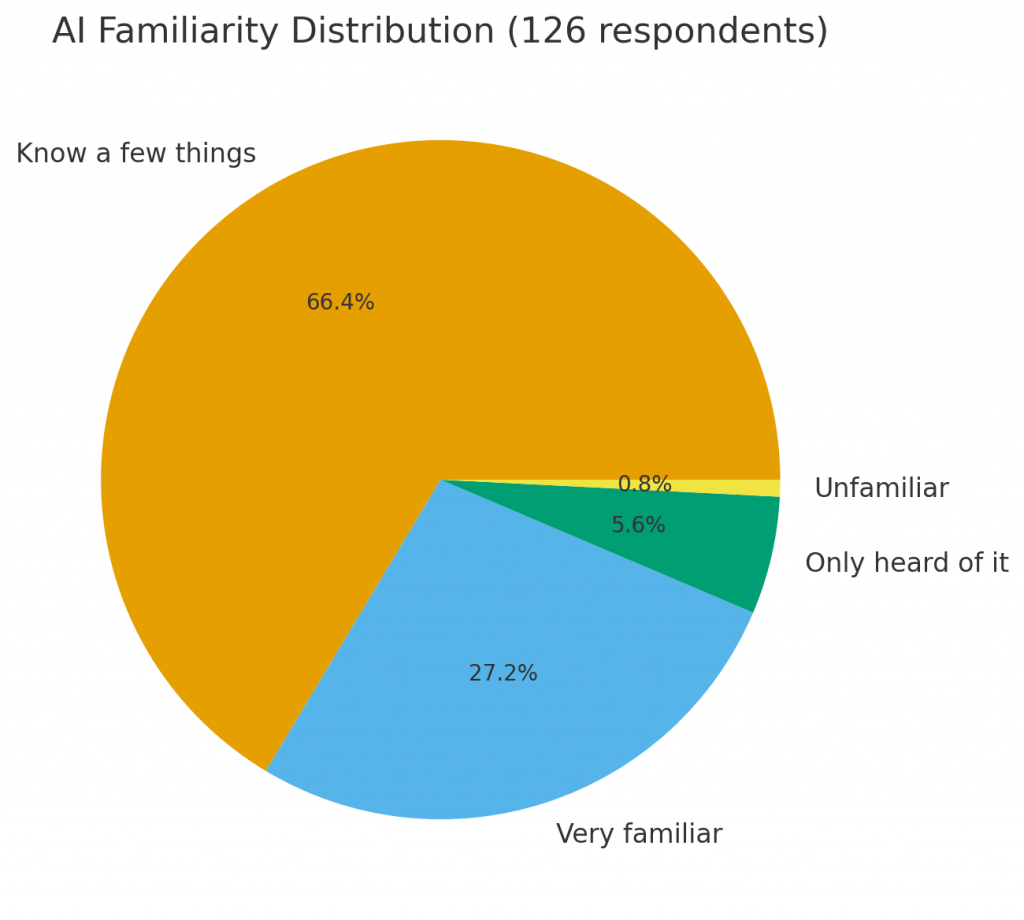
- Know a few things: 83 (65.9%)
- Very familiar: 34 (27%)
- Only heard of it: 7
- Unfamiliar: 1
Over 90% show some understanding; nearly one-third consider themselves “very familiar.”
AI usage (Q3) + frequency (Q5)
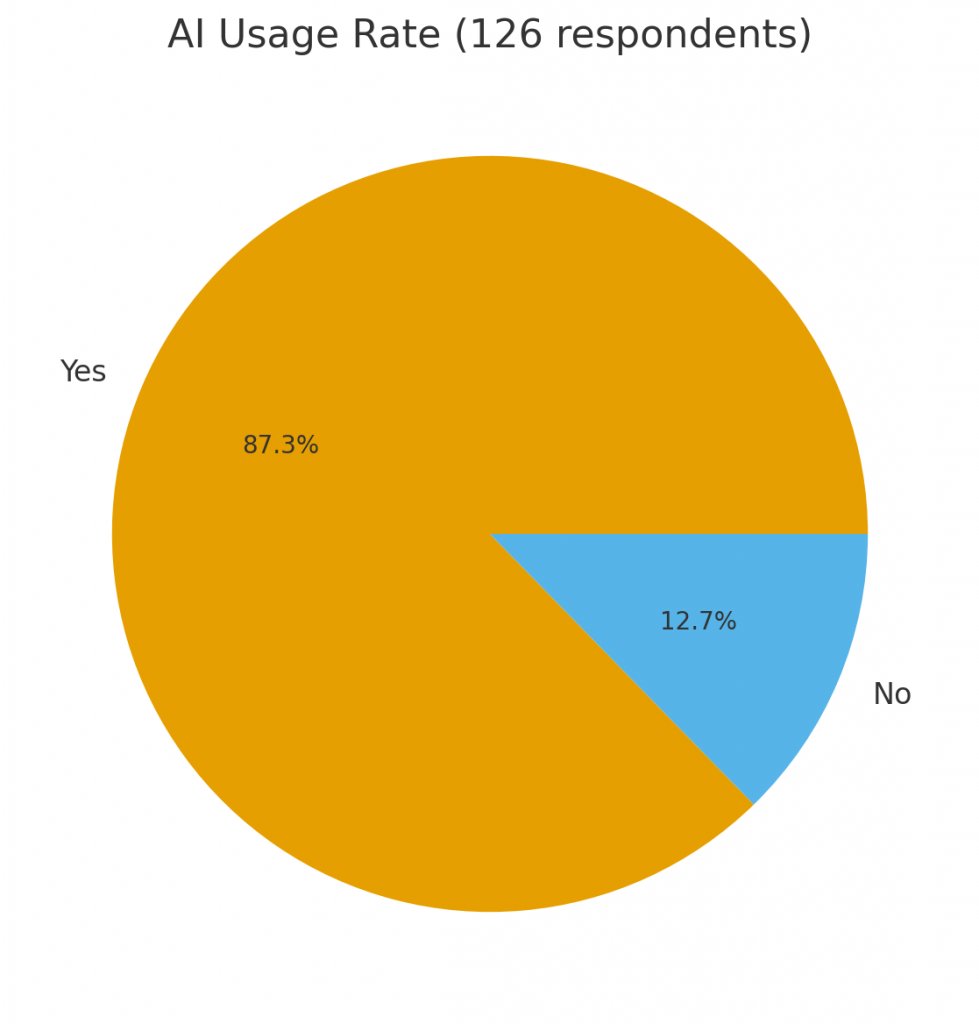
- Use AI tools: 110 (87.3%)
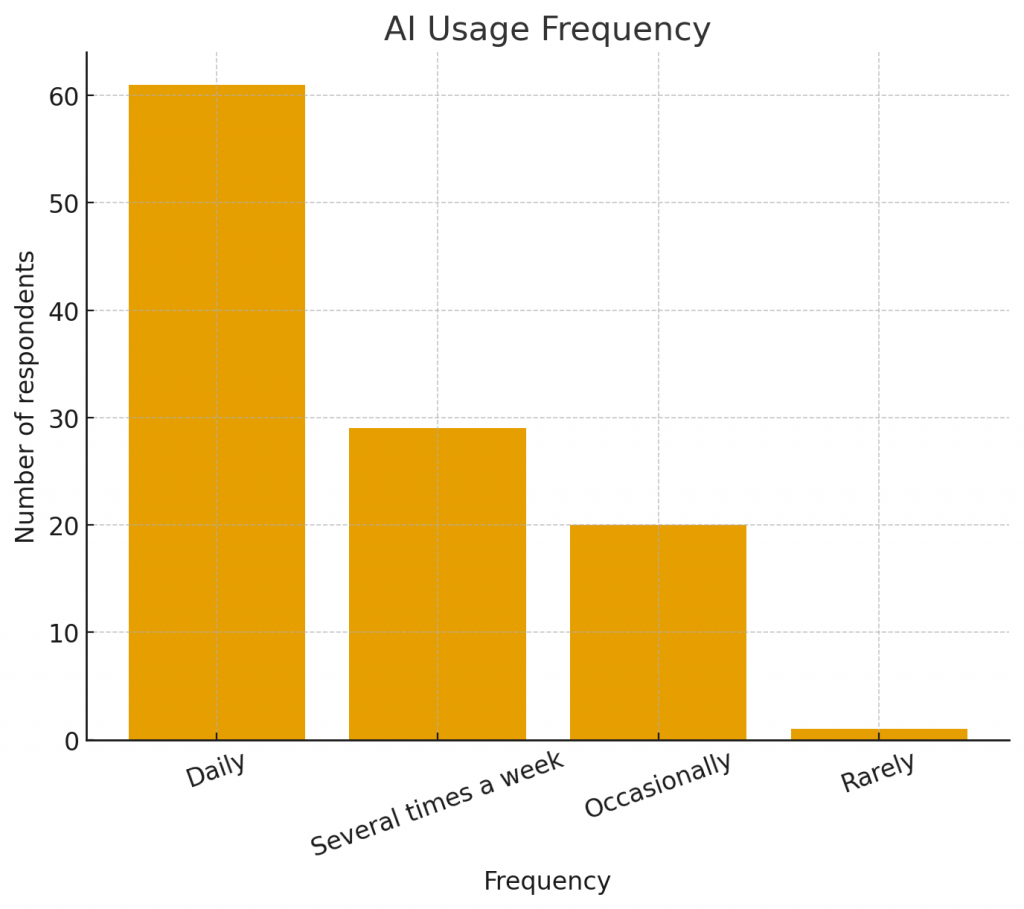
- Daily use: 61 (55%)
- Several times/week: 29 (26%)
- Occasionally: 20
- Rarely: 1
AI is already a daily basic tool, not an occasional novelty.
Preferred AI tools(Q4)
- Text-based AI: ChatGPT, Gemini, Claude
- Image-based AI: Midjourney, Firefly, Runway
- Productivity tools: Notion AI, Copilot
AI usage scenarios (Q6)
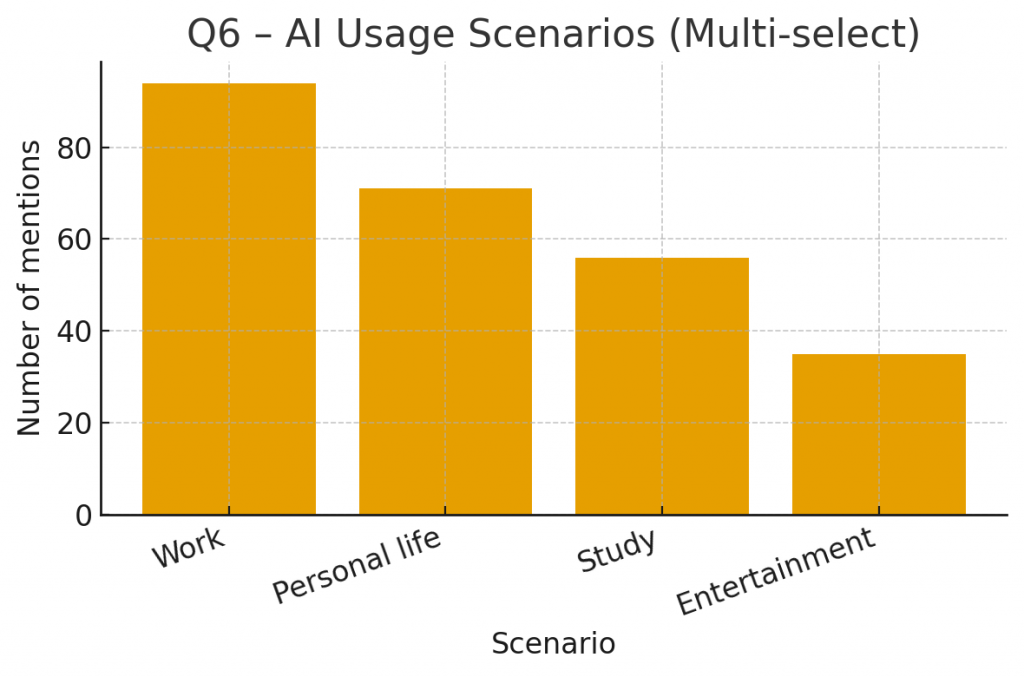
(Multiple choices >126)
- Work: 94 (74.6%)
- Personal life: 71 (56.3%)
- Study: 56 (44.4%)
- Entertainment: 35 (27.8%)
AI is embedded in both work and personal life, influencing decisions, organisation, and creativity.
Fields where AI is seen as most promising (Q7)
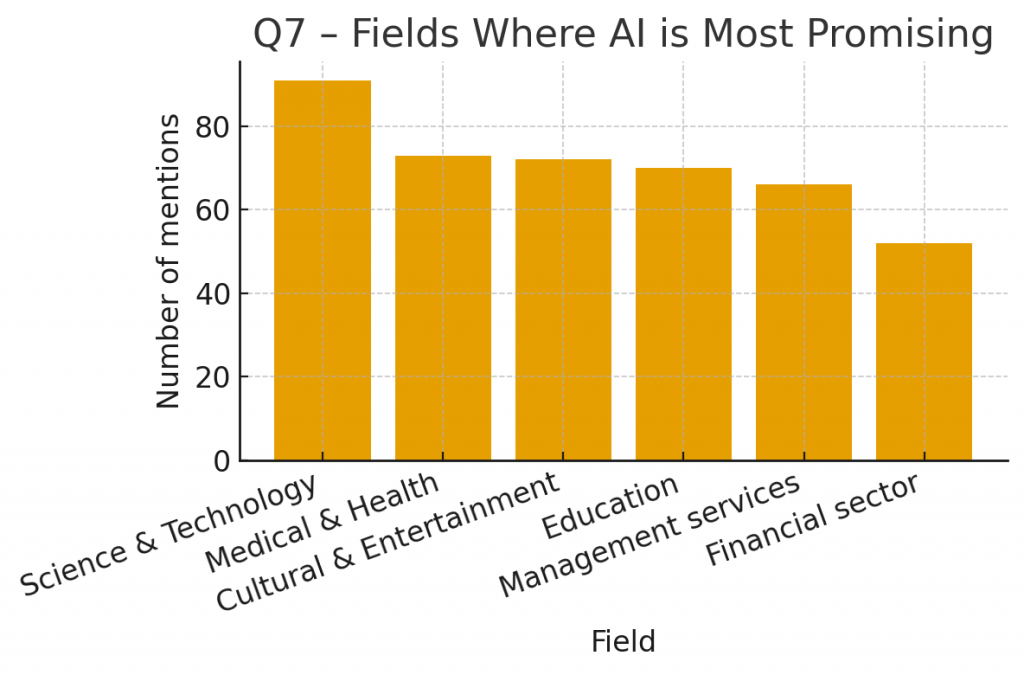
- Science & Technology: 91
- Medical & Health: 73
- Cultural & Entertainment: 72
- Education: 70
- Management services: 66
- Finance: 52
AI is viewed as infrastructure technology driving major sectors.
Perceived AI penetration (Q8) + societal impact (Q9)
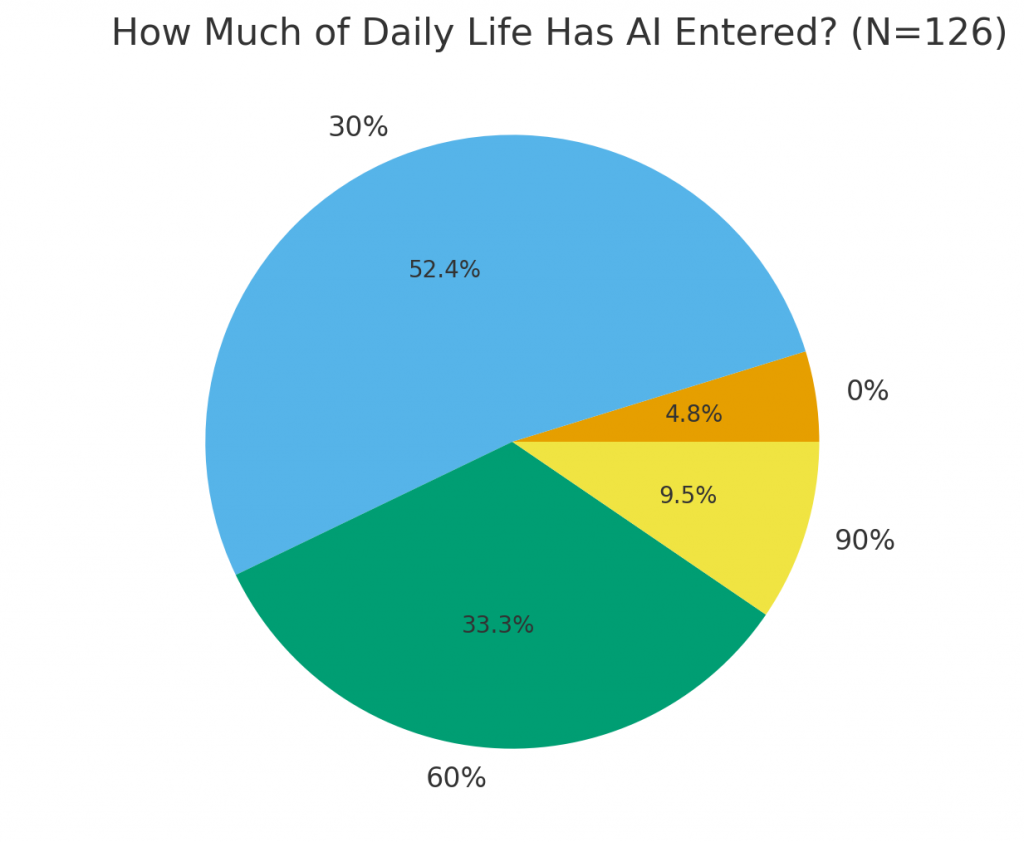
- AI penetration (30–60%): majority
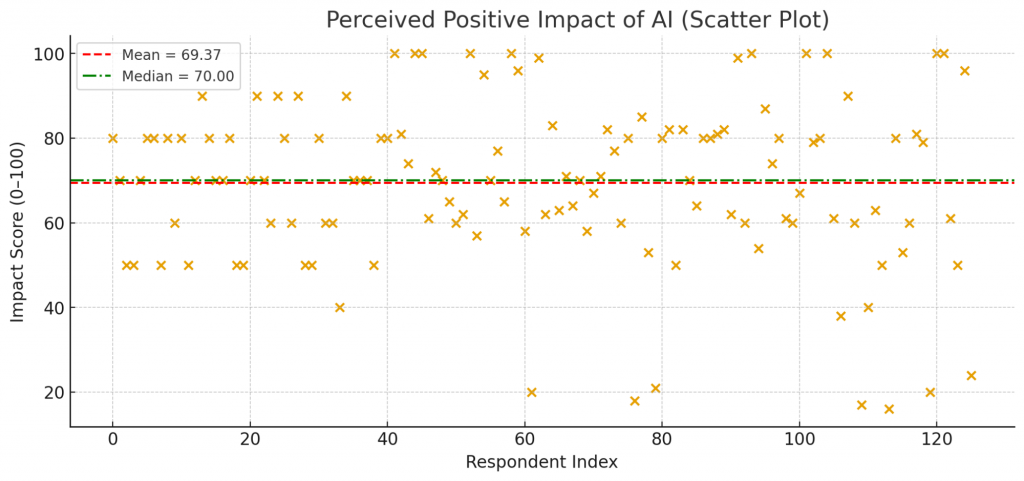
- Societal impact score: average ~69.4
Respondents believe AI’s benefits outweigh its risks, with cautious optimism.
Findings from Q2–Q9 demonstrate that AI functions as an everyday infrastructural technology, deeply integrated into the visual processing and decision-making systems of the general public.
3.3 Part 2 — Perception of AI-generated Content (Q10–Q12)
Awareness of AI-generated content (Q10)
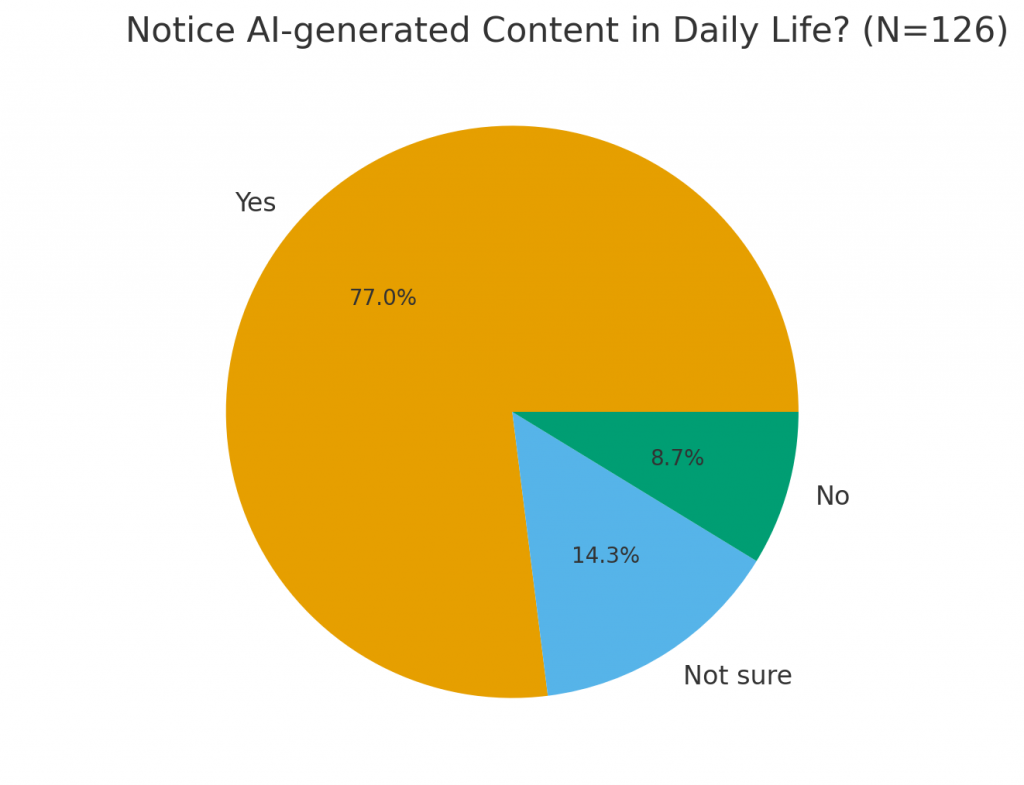
- Yes: 97 people (77.0%)
- Not sure: 18 people (14.3%)
- No: 11 people (8.7%)
People already widely recognize AI content in daily media.
Impressions of AI-generated visuals (Q11)
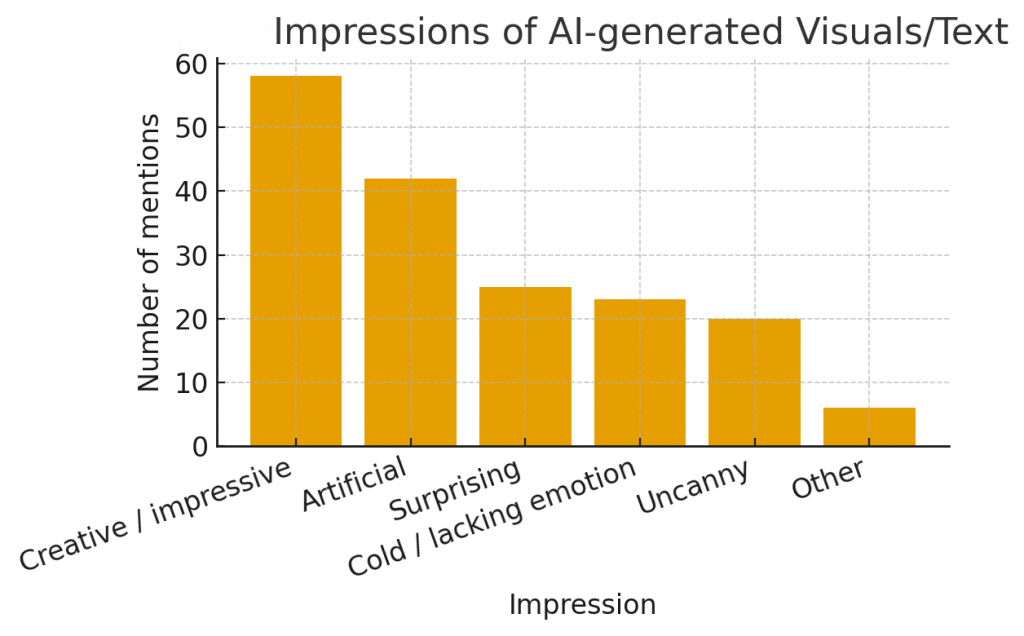
(Multiple choices)
- Creative/impressive: 58
- Artificial: 42
- Cold or lacking emotion: 23
- Uncanny: 20
“Creative” and “artificial/cold” frequently co-exist, reflecting a duality between novelty and distrust.
Ability to distinguish AI (Q12)
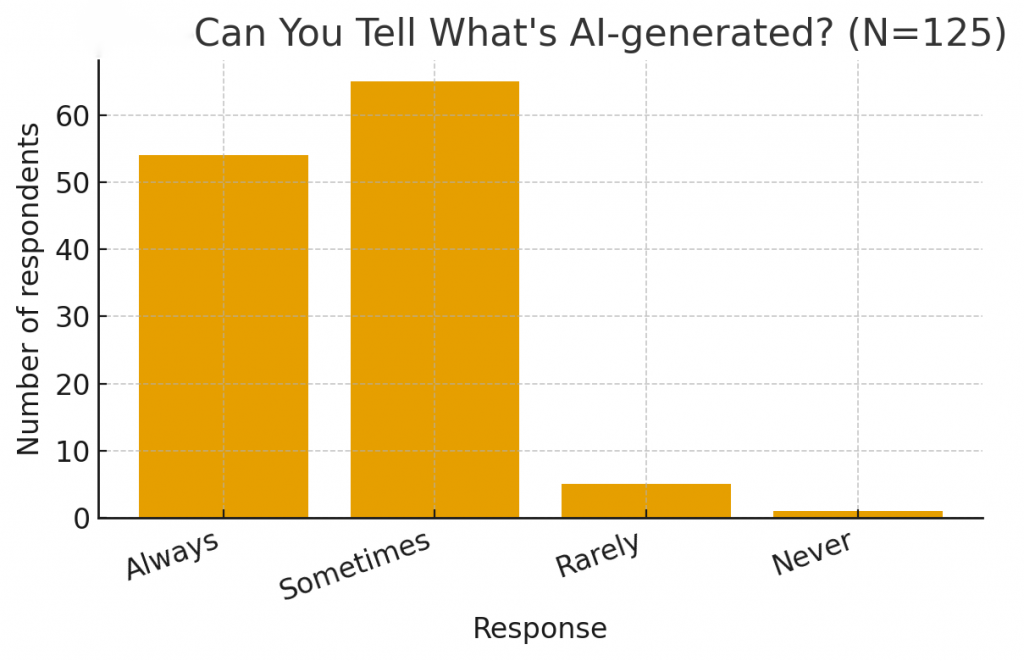
- Sometimes: 65
- Always: 54
Many believe they can identify AI content, though this confidence may be overly optimistic.
3.4 Part 3 — Attitudes toward AI, Creativity, Emotion, and Future Roles (Q13–Q14)
Attitude toward AI becoming more pervasive (Q13)
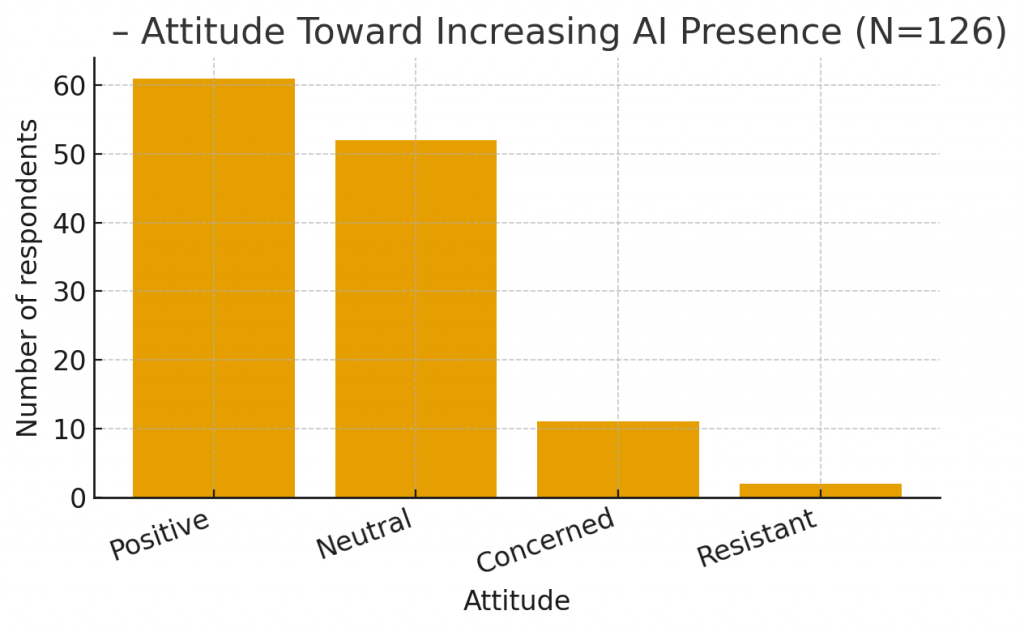
- Positive: 48.4%
- Neutral: 41.3%
- Concerned: 8.7%
AI is widely accepted, though people remain observant.
Role of AI in future creative work (Q14)
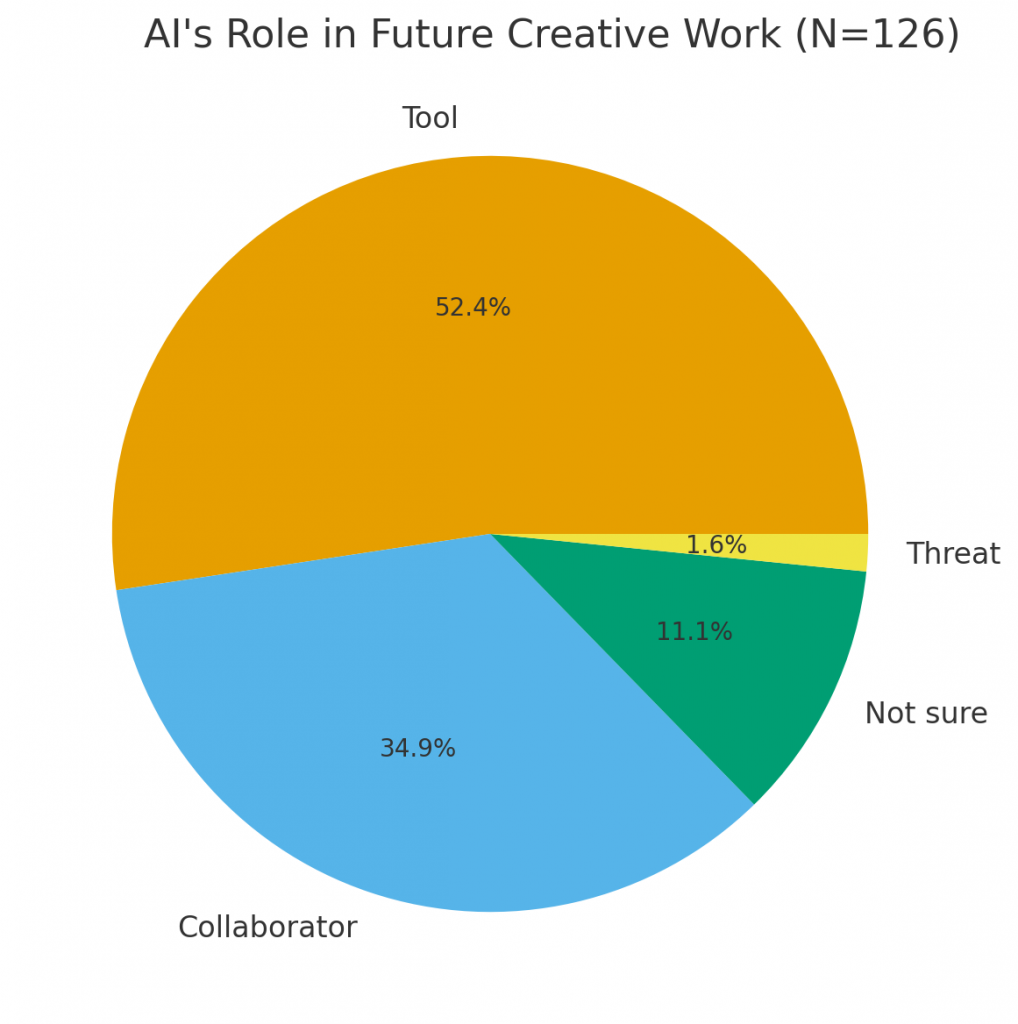
- Tool: 52.4%
- Collaborator: 34.9%
- Threat: 1.6%
The public favors human–AI co-creation, not replacement.
Overall Insights: What does this survey reveal?
1. AI is deeply integrated into the daily lives of highly educated groups, especially students, creative professionals, and knowledge workers.
2. Respondents show cautious optimism—positive toward AI’s benefits but attentive to its risks.
3. AI-generated visuals are perceived as highly creative yet emotionally cold, artificial, or uncanny.
4. Users are curious but skeptical—open to AI content but expecting brands to maintain authenticity and human warmth.
5. AI is seen as a powerful emotional language tool, but emotional depth, trust, and warmth still come from humans.
6. For the future, AI is viewed mainly as a tool + collaborator, not an adversary.
4. Open Discussion Following the Survey
Based on the survey findings, I organized a structured open discussion centered on few key thematic areas, exploring perceptions of AI creativity, emotional expression, authenticity, and brand implications.
Survey Findings: Key Insights & Summary
1 Changed daily and work habits
Key insights:
- AI has shifted from a “tool” to a daily infrastructure, transforming how people search, learn, and work.
- Many participants reported abandoning Google/Baidu and turning to AI first for problem-solving, planning, and information extraction.
- Knowledge workers describe AI as a “productivity booster,” “assistant,” or “second brain”, using it for emails, summaries, reports, ideation, and task automation.
- Some participants noticed changes in their cognitive habits—becoming more dependent on AI for structure, language, or decision-making.
- Creatives rely on AI for image generation, moodboards, editing, and video production, reducing dependence on traditional tools.
AI now influences the full chain of searching, learning, creating, communicating, and decision-making.
2 Noticed AI-generated content in daily life
Key insights:
- AI-generated content is most visible on social media: TikTok, Instagram, Xiaohongshu, Douyin—especially virtual influencers, synthetic imagery, and short AI videos.
- It is also widely present in advertising: metro stations, airports, malls, digital billboards, elevator screens, and app ads.
- High exposure in e-commerce (AI models on Taobao), brand visuals, livestreams, and product campaigns.
- Participants also detect AI-written articles, summaries, reports, and workplace documents.
AI content is perceived as ubiquitous—blending seamlessly into everyday media environments.
3 Trust on AI-generated information and visuals
Key insights:
- The majority express conditional trust
- Most participants describe AI as useful but unreliable without verification.
- Concerns include opaque sources, algorithmic bias, and potential manipulation.
- Visual AI content is often described as “beautiful but possibly fake.”
Overall: cautious, moderate trust—with a strong emphasis on cross-checking.
4 · AI’s strengths and limitations in creativity
Strengths:
- High efficiency and time-saving
- Breaks creative boundaries
- Enables low-cost experimentation
- Accessible to non-professionals
Limitations:
- Lacks lived experience and emotional perception
- Produces homogenised aesthetics
- Struggles with cultural nuance and context
- Requires human judgment to avoid shallow output
Insight: AI supports creative exploration but cannot replace deep, human creativity.
5 · Exposure to brands using AI & public perception
Key insights:
- Participants frequently encounter AI in brand campaigns, posters, films, new media works, and product concepts.
- Perceptions are mixed:
- Positive: innovative, fresh, visually appealing
- Negative: excessive AI use feels lazy, insincere, or emotionally distant
Public acceptance of “Brand × AI” is ambivalent—curiosity combined with skepticism about authenticity.
6 · Can AI express “emotion” or “human warmth”?
Key insights:
Three main perspectives emerged:
- “Yes, but only superficially.”
- AI can express colour, mood, atmosphere—not genuine emotion.
- “No.”
- AI lacks lived experience and empathy; emotional expression is artificial.
- “It depends on humans.”
- Designers, narratives, and contexts add warmth—AI functions as a carrier, not the source.
Key insight: AI can convey emotional cues, but human warmth originates from humans—not the model itself.
- Designers, narratives, and contexts add warmth—AI functions as a carrier, not the source.
Overall Summary
- AI has become a foundational layer in daily information processing, work routines, and creative workflows.
- Users are highly aware of AI-generated content and view it as everywhere, yet maintain cautious trust.
- AI’s strengths lie in efficiency, exploration, and accessibility; its limitations centre on authenticity, emotional depth, and cultural nuance.
- Public attitudes toward AI-powered branding combine curiosity with skepticism, especially regarding authenticity.
- Participants generally agree that AI can deliver emotional aesthetics, but cannot create genuine human emotion.
AI is increasingly involved in emotional and creative experiences—but its limitations are becoming equally visible.
References
BoF Team & McKinsey & Company (2023) ‘The Year Ahead: How Gen AI Is Reshaping Fashion’s Creativity’, The Business of Fashion, 18 December. Available at: https://www.businessoffashion.com/articles/technology/the-state-of-fashion-2024-report-generative-ai-artificial-intelligence-technology-creativity/ (Accessed: 24 July 2025).
Charlie, A. and Veronika, B. (2025) The Evolution of Artificial Intelligence: A 15-Year Review. New York: TechFuture Press.
Christopher, J. (2025) ‘Consumer attitudes toward brand use of AI from 2023–2024’, Journal of Digital Consumer Behaviour, 12(1), pp. 44–59.
Grand View Research (2024) Artificial Intelligence Market Size, Share & Trends Analysis Report. Available at:
https://www.grandviewresearch.com/industry-analysis/artificial-intelligence-ai-market
(Accessed: 20 July 2025).
Katherine, L. (2024) ‘AI Growth and Business Impact’, Forbes Advisor, 18 April. Available at:
https://www.forbes.com
(Accessed: 29 July 2025).
ResourceRa (2025) AI Global Usage Statistics. Available at:
https://resourcera.com/data/artificial-intelligence/ai-statistics/
(Accessed: 27 July 2025).
Rufo, Y. (2025) ‘Does this look like a real woman? AI model in Vogue raises concerns about beauty standards’, BBC News, 27 July. Available at:
https://www.bbc.co.uk/news/articles/cgeqe084nn4o
(Accessed: 22 November 2025).
Yu, M., Zainal Abidin, S. and Shaari, N. (2024) Effects of Brand Visual Identity on Consumer Attitude: A Systematic Literature Review. Preprints.org, 16 May. Available at:
https://www.preprints.org/manuscript/202405.1109.v1
(Accessed: 27 July 2025).
Leave a Reply